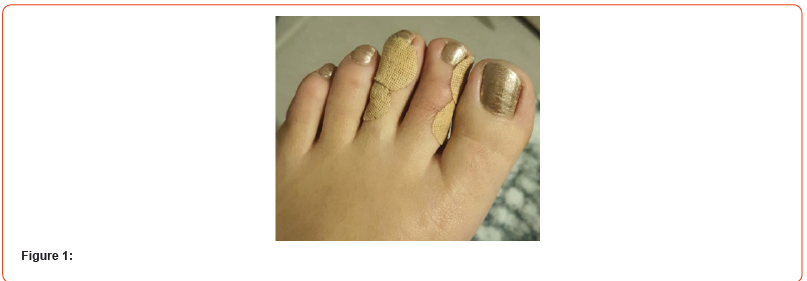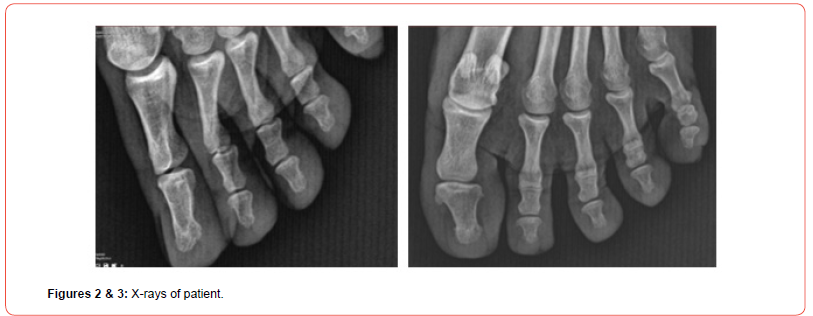 Case Report
Case Report
Covid-19 Induced Single-Toe Chilblain: A Case Report
Melis Akpınar Gözetici, Private Medar Ataşehir Hospital, Istanbul, Turkey.
Received Date:June 05, 2023; Published Date:June 16, 2023
Introduction
The COVID-19 infection first seen in Wuhan, China and rapidly spread across the world and became a pandemic. In the world, there have been nearly 175 million confirmed COVID-19 cases and 3.7 million associated deaths [1]. Characteristic clinical signs of COVID-19 are fever, fatigue, dry cough, anorexia, dyspnoea, ageusia, anosmia. Nasopharyngeal and oropharyngeal swab, which show the viral PCR, confirm the diagnosis [2]. In the literature, sporadically reported skin manifestations of COVID-19 are often morbiliform eruption, urticaria, vesicular eruption, acral lesions and livedoid eruptions. Some of these skin findings have been reported to appear earlier than symptoms associated with COVID-19 [3,4]. Herein, we reported a case with pain and erythema on the toe which appeared two days before the characteristic COVID-19 symptoms.
Case Report
A 30-year-old female patient admitted to the emergency service with the complaint of sudden onset pain in the 2nd toe of the left foot that had been present for 2 days. She had no other underlying diseases and denied recent exposure to cold temperatures or trauma. The patient had no additional complaints and whose vital signs were normal. On physical examination, there was mild redness and swelling on the skin, and there was no history or trace of a trauma or an insect bite (Figure 1). Radiologic examinations and orthopedic concultations did not show any bone pathology (Figure 2 & 3).


Soft tissue injury diagnosis was thought and resting with a plaster splint, elevation and ice application recommended. Two days later, the patient has readmitted to the hospital with the complaints of fatigue, sore throat, fever, nasal congestion, rhinorrhea, headache, loss of taste and smell. Nasopharyngeal swab of the patient was positive for Severe acute respiratory syndrome coronavirus-2 (SARS CoV-2) PCR. Therefore, prior complaint about the toe was considered to be COVID-19-induced chilblain. In laboratory tests, complete blood cell count; erythrocyte sedimentation rate; coagulation tests; D-dimer; renal, hepatic functions; urine tests were normal. The patient, who did not have cough and respiratory distress, was followed up at home with favipiravir treatment in accordance with the national COVID-19 treatment protocol. The patient, whose double dose vaccination was completed 4 months ago, showed complete recovery 3 days after the diagnosis.
=Discussion
Chilblain/pernio-like lesions are edematous/erythematous lesions mostly reported in young adults, and it has been reported that they regress spontanously after infection [5]. In an article from Spain, chilblain was detected in 19% of 375 patients infected with COVID-19. Chilblain-like lesions, which can be painful or itchy, were regressed in an average of 2 weeks and were seen slightly more in women [6,7]. The most important differential diagnosis of pernio/ chilblain-like lesions are livedoid vasculopathy and acral ischemia which have thought to develop secondary to COVID-19 induced thrombotic vasculopathy, hypercoagulation state, or disseminated intravascular coagulation in severely ill patients, usually in the intensive care unit [3,7-9].
Recent articles reported positive COVID-19 serology in only 30% of patients who presented with chilblain-like lesions suggesting that these lesions are associated with mild/asymptomatic SARSCoV- 2 infection or a good prognosis [8,10]. Similarly in our case, full recovery was achieved only in 3 days.
Conclusion
Chilblain-like lesion on one finger has not been reported in a COVID-19 patient before. This case report was written to draw attention to the early diagnosis of Covid-19 with cutaneous onset. Further studies on COVID-19 related skin manifestations is needed for early diagnosis, proper management and treatment of the disease.
Acknowledgement
None.
Conflict of Interest
No conflict of interest.
References
- Coronavirus Outbreak: Daily Updates. https://www.healthline.com/health-news/coronavirus-live-updates.
- Wang D, Hu B, Hu C, Zhu F, Liu X, et al. (2020) Clinical characteristics of 138 hospitalized patients with 2019 novel coronavirus-infected pneumonia in Wuhan, China. JAMA 323(11): 1061-1069.
- Young S, Fernandez AP (2020) Skin manifestations of COVID-19. Cleve Clin J Med.
- Wollina U, Karadağ AS, Rowland-Payne C, Chiriac A, Lotti T (2020) Cutaneous signs in COVID-19 patients: A review. Dermatol Ther 10: e13549.
- Alramthan A, Aldaraji W (2020) Two cases of COVID-19 presenting with a clinical picture resembling chilblain: first report from the Middle East. Clin Exp Dermatol 45(6): 746-748.
- Galván Casas C, Català A, Carretero Hernández G, Rodríguez-Jiménez P, Fernández-Nieto D, et al. (2020) Classification of the cutaneous manifestations of COVID-19: a rapid prospective nationwide consensus study in Spain with 375 cases. Br J Dermatol 183(1): 71-77.
- Estébanez A, Pérez-Santiago L, Silva E, Guillen-Climent S, García-Vázquez A, et al. (2020) Cutaneous manifestations in COVID-19: a new contribution. J Eur Acad Dermatol Venereol 34: e250-e251.
- Ludzik J, Witkowski A, Hansel DE, Raess PW, White K, et al. (2020) Case Report: Chilblains-like lesions (COVID-19 toes) during the pandemic- is there a diagnostic window. F1000Res 9: 668.
- Zhang Y, Cao W, Xiao M, Li YJ, Yang Y, et al. (2020) Clinical and coagulation characteristics of 7 patients with critical COVID-2019 pneumonia and acro-ischemia. Zhonghua Xue Ye Xue Za Zhi 41: E006.
- Hubiche T, Le Duff F, Chiaverini C, Giordanengo V, Passeron T (2021) Negative SARS-CoV-2 PCR in patients with chilblain-like lesions. Lancet Infect Dis 21(3): 315-316.
-
Melis Akpınar Gözetici*. Covid-19 Induced Single-Toe Chilblain: A Case Report. On J Cardio Res & Rep. 7(4): 2023. OJCRR. MS.ID.000666.
-
Food consumption levels, Dietary patterns, Predictors of Metabolic Syndrome, Burden of cardiovascular diseases, Diabetes, Cirrhosis, Cardio-metabolic diseases, Coronary heart disease, Liver cirrhosis, Infectious diseases, Blood glucose, Blood pressure
-

This work is licensed under a Creative Commons Attribution-NonCommercial 4.0 International License.






